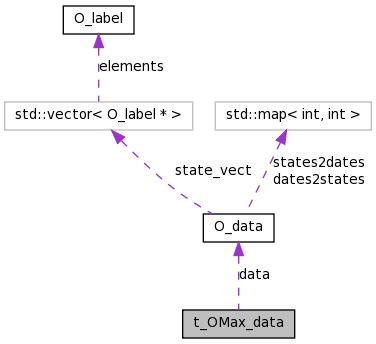
OMax.data external. More...
#include <OMax.data.h>

Public Attributes | |
| t_object | ob |
| Pointer to the object itself. | |
| t_symbol * | oname |
| Pointer to FO name. | |
| O_DataType | datatype |
| Type of data. | |
| int | nbcoeffs |
| Number of coefficient for Spectral data. | |
| t_symbol * | dataname |
| Pointer to Data Sequence name. | |
| O_data | data |
| Data sequence. | |
| t_int32_atomic | wflag |
| Writing flag. | |
| t_int32_atomic | readcount |
| Reader Count. | |
| bool | noDelete |
| Keep Data states. | |
| void * | out0 |
| Outlet 0 (leftmost). | |
Standard Max5 methodes | |
|
| |
| void * | OMax_data_new (t_symbol *s, long argc, t_atom *argv) |
| Object instantiation. | |
| void | OMax_data_free (t_OMax_data *x) |
| Object destruction. | |
| void | OMax_data_assist (t_OMax_data *x, void *b, long io, long index, char *s) |
| Inlet/Outlet contextual information when patching in Max5. | |
Input/Output routines | |
|
| |
| void | OMax_data_size (t_OMax_data *x) |
| Get the size of the Data Sequence. | |
| void | OMax_data_init (t_OMax_data *x) |
| Initialise the Data Sequence structure. | |
| void | OMax_data_reset (t_OMax_data *x) |
| Reset the Data Sequence structure. | |
| void | OMax_data_type (t_OMax_data *x) |
| Set data type of the sequence. | |
Internal routines | |
|
| |
| t_symbol * | OMax_data_name (t_symbol *oname) |
| Return Data Sequence name from FO name. | |
OMax.data external.
This external object ports Data Sequence structure into Max5. Input handeled are messages size, init, and reset
Definition at line 31 of file OMax.data.h.
| void OMax_data_free | ( | t_OMax_data * | x | ) |
Object destruction.
Depending on t_OMax_data::noDelete value, erase every state of the Data Sequence by calling O_data::freestates or keeps it */
Definition at line 155 of file OMax.data.c.

| void OMax_data_init | ( | t_OMax_data * | x | ) |
Initialise the Data Sequence structure.
init Definition at line 214 of file OMax.data.c.

| t_symbol * OMax_data_name | ( | t_symbol * | oname | ) |
Return Data Sequence name from FO name.
Append _data to the FO name
Definition at line 269 of file OMax.data.c.
| void * OMax_data_new | ( | t_symbol * | s, | |
| long | argc, | |||
| t_atom * | argv | |||
| ) |
Object instantiation.
The first argument given to the Max5 object is considered as a valid FO name (and stored in member t_OMax_data::oname). Then declares name_data as the Data Sequence name (member t_OMax_data::dataname) and links it with the OMax.data object.
Definition at line 73 of file OMax.data.c.

| void OMax_data_reset | ( | t_OMax_data * | x | ) |
Reset the Data Sequence structure.
reset Depending on t_OMax_data::noDelete value, erases every state of the Data Sequence by calling O_data::freestates or keeps it and calls O_data::clear_vect instead
Definition at line 230 of file OMax.data.c.

| void OMax_data_size | ( | t_OMax_data * | x | ) |
Get the size of the Data Sequence.
size Definition at line 206 of file OMax.data.c.

| void OMax_data_type | ( | t_OMax_data * | x | ) |
Set data type of the sequence.
type Definition at line 257 of file OMax.data.c.
 1.6.1
1.6.1